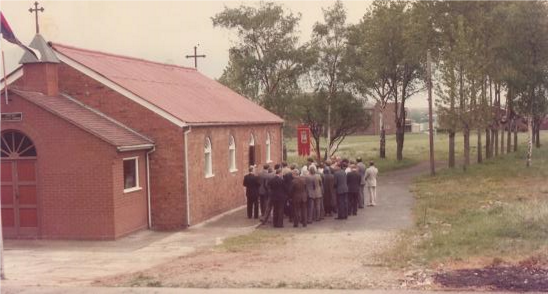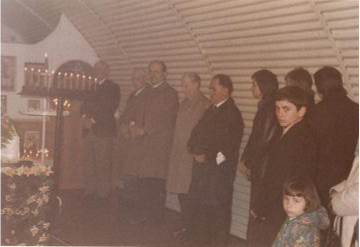A history of the Serbian Orthodox Community of St Nicholas, Donnington, Telford

Had it not been for the Second World War, Serbs would not have found their way to Shropshire and settled in the Donnington area of Telford. After the war, a large number of Serbs who had remained loyal to the King found themselves amongst Europe’s displaced peoples, arriving in the UK in 1947/8 as European Voluntary Workers (EVWs). Most EVWs were men aged up to 45 years who were given work in mines, foundries or on farms. Each EVW was contracted to work for three years in one of these shortage areas before being allowed to find other work if they wished.
As these three-year contracts drew to a close in or around 1952, Serbs and other Eastern Europeans dispersed around England & Wales in search of new jobs. Many went to London, Birmingham, Leeds, Oldham, Huddersfield, Bristol, Leicester or other cities or industrial centres. Some came to Donnington to work at the Central Ordnance Depot (COD). Here they joined Poles who had previously been subjected to forced labour by the Nazis (as opposed to Poles who had fought with British forces), Ukrainians, Lithuanians and Russians.
As there was a housing shortage, accommodation was provided for several hundred men in a disused army camp of Nissen huts on the site of present-day Barclay Court. Camp Leaders were appointed, one for each nationality. The Serb Community Leader was a former Captain of the pre-war Yugoslav Army who had been held in a Nazi Prisoner of War camp during the war. Miodrag Krsmanovic spent over thirty years serving the Serb community and Church in Donnington. The MBE he was awarded by the Queen is displayed on the wall of our Church porch.
Most residents of the Camp, including the Serbs, had experienced atrocities during that horrendous war, but all displayed resilience, stoicism and, in spite of all that they had been through, strong faith in God and a truly inspiring hope for the future. Catholics amongst them, such as Poles, joined existing local Catholic congregations. Such a solution was not available to Orthodox Christians, the majority of whom were Serbs. Therefore, parishes of the Serbian Orthodox Church were being set up around England in London (where the King and his family had been living since the 1940s), Birmingham, and Derby. The Derby parish took in Leicester, Stoke-on-Trent and Donnington.

In Donnington, a Nissen hut was designated for use as the Serbian Orthodox Church of St Nikola (or Nicholas). Orthodox Christians of other nationalities formed part of the congregation from the outset. The Donnington congregation was served by Father Dimitrije Najdanovic who was based in Derby. He is fondly remembered by some of older parishioners as a learned man of the people.
In those early days following the war, many people found themselves separated from family who were still in Yugoslavia. Others had no living family having lost family members to the war. The war had been brutal and physical survival was sometimes accompanied by mental torment. War had also curtailed promising careers, education, family lives. Those with education usually fared better than those without but as a rule immigrants often found employment at below their capability. War had also interrupted communication with relatives, but once it was re-established letters could be exchanged – instant communication was still a little way off. Low levels of literacy kept letter writers and readers in great demand. At some point men realised there would be no imminent return to former lives and former homes in a country that was now communist. They set about making the most of new opportunities.
Another great change began in the mid to late 1950s – the arrival of wives and daughters to visit some of the older men and the prospect of potential wives for younger unmarried men. This was closely followed by a second generation of Serbs born in this country. Women and children were simply not allowed to live in the Nissen camp and nearby accommodation had to be found. Men usually worked at COD and if wives worked it was often at GKN Sankey or Russell’s rubber factory, and they were no strangers to the night shift. They all kept serious gardens, even those Iiving in Nissen huts had some allotments. God-fearing, hard-working and respectful of the laws and traditions of their new country, they raised families and worshipped at St Nikola’s.
Children were always welcome to visit the camp – a Nissen hut was kitted out as a schoolroom and classes were held for approximately 15 children in the 1960s. Lessons were held on Sundays and given by community members who’d been trained as teachers back in pre-war Yugoslavia. Annual prize giving was a feature of the school year and Christmas Eve was always a highlight with the decoration and blessing of the traditional Badnjak (yule).
As we moved into the 1970s, numbers living in the Nissen huts inevitably reduced – some had moved into private accommodation often with wives and families as mentioned above. Others had left for towns and cities to be closer to friends, some had passed away or in a few cases returned to Yugoslavia.
By 1974, Nissen huts, including our church, were being demolished and replaced by residential accommodation as part of Barclay Lodge. Plans for converting a storehouse situated in the middle of the camp into a new church were discussed and debated and taken forward with great enthusiasm. All families donated money, and, more than that, all the men of the parish worked on the conversion in their free time – a sign of their commitment to the church of St Nikola.
The new church was consecrated in May 1974 – a big day in the history of the Donnington community. Guests from COD Donnington, the local Council, Serbs from around the country and other Orthodox Slavs attended. The fact that Oakengates Town Hall was hired for a celebratory programme of entertainment that afternoon should give you an idea of numbers.
Nowadays, Serbian is spoken as a first language only by those born in the former Yugoslavia. The second generation learned their Serbian before their English, often starting school with little or no English, but English soon took over as the dominant language. For the third generation, it is inevitably harder to maintain use of the Serbian language. Much of the second generation married outside the community and even where they didn’t, integration into wider British society was and is possible in many ways, especially given the diversity and tolerance of today’s Britain.
Looking forward, our hope is for the Church of St Nikola to continue as a thriving Orthodox Christian community. This would be a fitting tribute to the Church’s founding fathers (and mothers!), their optimism in the face of hard times and all that they did for the sake of future generations.
Mileva Novkovic
February 2015